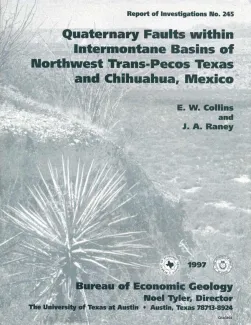
Publication Details
Geolocation:
Get the Publication
$12.00
Abstract/Description:
This report details the occurrence, geometries, scarp morphology, and paleorupture histories of Quaternary faults of northwest Trans-Pecos Texas and northern Chihuahua, Mexico. This study area encompasses a part of the east margin of the Southern Basin and Range-Rio Grande rift tectonic province. Pre-Cenozoic tectonism and its influence on the Cenozoic structural history is also reviewed. Basins studied include the Hueco, Red Light, Northwest and Southeast Eagle Flat, Green River, Salt, Wild Horse, Lobo Valley, and Ryan Flat Basins. Aerial photographs and outcrops were analyzed in conjunction with borehole and seismic data to evaluate the region's structural and stratigraphic framework and the attributes of the Quaternary faults. Regional Cenozoic extension produced northwest- and north-northwest-trending, fault-bounded basins and adjacent mountain ranges that were superimposed upon preexisting Tertiary, Mesozoic, and older tectonic features. Similar strikes of pre-late Cenozoic structures and the superimposed late Cenozoic basins and faults indicate that the preexisting structural grain influenced geometries of the late Cenozoic basins and associated faults. The Hueco Bolson, the most tectonically active Cenozoic basin of the region, locally contains as much as 3 km of fill. Other basins contain less than 900 m of Cenozoic basin fill. Evidence of Quaternary tectonism is recorded by displacement of middle and upper Pleistocene deposits across range-bounding and intrabasinal faults. Middle Pleistocene displacement varies from less than 1 to 32 m. The larger displacement faults vertically offset upper Pleistocene deposits between 1 and 6 m. For some of these faults, early Holocene fault movement is likely, although not precisely dated. Even on the most active faults, average slip rates since the middle Pleistocene are low, at less than or equal to 0.1 mmlyr. Maximum vertical displacements during large surface rupture events were between 0.5 and 3 m. Average recurrence intervals since the middle Pleistocene of large surface ruptures are relatively long--15,000 to 160,000 yr, although faulting events are probably episodic. Knowledge of structural setting and Quaternary tectonism of these basins and associated faults provides clues about these basins' structural development, as well as the structural history of the southeast margin of this extensional tectonic province. These studies are also useful in seismic risk studies related to designing critical facilities such as the proposed Eagle Flat low-level radioactive waste repository.